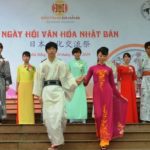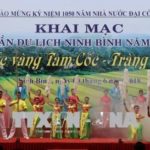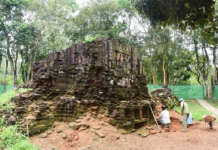Vietnam is undeniably a rice country, as rice plays a significant role in the daily diet of its people. Consumed twice a day, it is considered a staple for breakfast, lunch, dinner, and even as a snack. This emphasizes the crucial role of rice in the Vietnamese culture and lifestyle. Interestingly, rice has also found its way into a unique form of art called rice painting, further exemplifying its significance in the country.
Given their uniqueness and attention to detail, paintings made entirely out of rice have become increasingly popular among art enthusiasts. These beautiful works of art captivate viewers with their intricate designs and exquisite craftsmanship. The use of rice as a medium adds a distinct texture and organic quality to the paintings, enhancing their overall appeal. Art aficionados are drawn to these unique pieces for their innovative use of materials and the skill required to create them. Whether it’s the delicate strokes or the intricate patterns, rice paintings never fail to impress and leave a lasting impression on those who appreciate their beauty.
Artists must be meticulous in selecting the type of rice and then roasting or drying it to create different shades of color. It is believed that the natural colors of roasted rice are vibrant and long-lasting, surpassing those of most other materials.
Rice paintings are believed to have originated in India and gained popularity in tourist destinations such as Hanoi, Ho Chi Minh City, Hoi An, and Dalat starting around 2010.
It didn’t take long for rice painting to gain fame in Vietnam. Instead of being just another souvenir, they became something truly special to take home.
One of the most popular gifts for special occasions, such as the APEC meetings in Vietnam (2017), the ASEAN Summit (2020), and others, are the exquisite paintings created by talented Vietnamese artisans from Quynh Vy Rice Paintings based in Ho Chi Minh City. These unique artworks showcase the beauty of Vietnamese culture and are cherished by recipients from around the world.
“The rice paintings showcasing the beauty of Vietnam have been highly praised by both overseas Vietnamese and international tourists,” said artist Dang Khoa, the creator of Quynh Vy Rice Paintings.
He also opened rice painting classes for foreigners and popularized this painting in local schools. This not only allowed foreigners to learn and appreciate the art form, but also brought attention and recognition to rice painting within the local community. By offering these classes, he encouraged people from different cultural backgrounds to come together and learn about the unique technique involved in rice painting. Moreover, by introducing this art form to local schools, he exposed younger generations to a traditional art form that they may not have been familiar with before. This helped to ensure the preservation and continuation of rice painting as an important part of the local artistic heritage.
The rising popularity of rice paintings is partially attributed to the growing number of tourists who regard these artworks as cherished souvenirs. Aiding in this trend are the sentiments of foreign visitors who seek affordable mementos that evoke their memories of Vietnam. Nguyen Thi Van, a rice painter from Phu Lo Commune in Soc Son District, just outside of Hanoi, attests to the fact that many international tourists are on the lookout for reasonably-priced souvenirs that serve as meaningful reminders of their time in Vietnam.
Van, a talented artist from Hanoi, is known for her unique and skillful rice paintings. With a passion for art, she completed her first rice painting in 2015, marking the beginning of her artistic journey. The following year, Van made the bold decision to transition from being a preschool teacher to fully pursuing her passion for rice painting. She opened her own gallery in 2016, showcasing her beautiful creations and attracting art enthusiasts from all around. Van’s dedication to her craft and her ability to transform simple grains of rice into mesmerizing works of art truly set her apart as one of the few rice painters in Hanoi.
“They buy these paintings to enhance the aesthetics of their homes with an authentic Vietnamese touch, all at an affordable price,” she confidently stated.
Alan Smith, a tourist visiting Hanoi, expressed his fascination with rice painting.
Although rice painting may not possess the same collector value as oil, lacquer, or silk art, it still holds its own place in the market. Its distinctiveness stems from its chic and one-of-a-kind material, exclusive to Southeast Asia, as highlighted by an interviewee in The Hanoi Times.
Revamped: Transforming rice into art presents an intriguing opportunity to boost Vietnam’s rice exports. Ranking as the world’s third largest rice exporter in 2022, after India and Thailand, and the seventh largest rice consumer, this innovative approach effectively showcases Vietnam’s significant presence in the global rice market.
“Rice is not just a food item, it is also considered a work of art,” she believed. “People from all over the globe can witness and appreciate Vietnam’s rich wet-rice culture,” she declared.
Soon after opening her first gallery called “Quan Van Rice Paintings” in her hometown in 2016, Van quickly capitalized on her unique artworks by turning them into commercial successes.
Van’s rice paintings quickly gained popularity among both domestic and international tourists. They were captivated by the unique material she used and were amazed by her ability to seamlessly blend classical and modern styles in her artwork.
In 2021, Quan Van’s rice painting was recognized as a 4-star OCOP (One Commune – One Product) product of Hanoi, showcasing the exceptional craftsmanship and artistic talent of this unique art form. With its intricate designs and attention to detail, Quan Van’s rice painting stands as a testament to the rich cultural heritage of Vietnam. This recognition not only highlights the skill and creativity of the artist, but also serves as a symbol of Hanoi’s commitment to preserving and promoting traditional handicrafts. Quan Van’s rice painting is truly a masterpiece that deserves to be celebrated and cherished for generations to come.
According to Nguyen Thi Van, creating rice paintings does not require much pain, but it does require a considerable investment of time and patience.
“For a truly exquisite rice painting, artisans must possess unwavering diligence, meticulous attention to detail, and an unwavering spirit of passionate creativity,” she passionately declared.
The artwork created by Van is made using jasmine rice as the material. Jasmine rice is a popular variety of rice that is extensively cultivated in the Mekong Delta region of southern Vietnam.
“The elongated and aesthetically pleasing shapes of the rice grains make it easier for artisans to arrange them to create beautiful designs. Additionally, the high quality of the rice ensures that the paintings created using it will last for a longer time,” she explained.
To enhance the presentation of rice paintings, Van utilizes a method of roasting the rice. Achieving an ivory hue involves gently heating the rice for approximately 30 minutes. Conversely, to obtain a deeper, darker brown shade, the rice must be roasted for a minimum of six hours.
After conducting numerous trials, Van has successfully managed to create a wide range of 42 different colors for her grains through the process of rice roasting.
The molding process for rice paintings is a highly intricate and elaborate one. It begins with the artist sketching the desired painting on a wooden block. Then, using a special type of glue, the artist painstakingly sticks each tiny rice grain onto the block. The selection and arrangement of the grains is done with great care to maximize the desired effects of light and shade, resulting in a finished work of art that appears almost three-dimensional.
A highly skilled artist can complete a 30x30cm painting in just three days, showcasing their expertise and efficiency. For larger pieces, such as an 80x100cm painting, the artist will dedicate nearly ten days to ensure every detail is perfected and the artwork truly comes to life. This allows the artist to fully capture the essence and magnitude of the larger canvas. In both cases, the artist’s passion and talent shine through, resulting in stunning creations that are sure to captivate viewers.
There are three types of rice chosen as materials, each serving a specific purpose for different details. Regular rice is selected for thin details, sticky rice for large, wide details, and broken rice for small details and smooth paintings. Each painting is meticulously created using hundreds, thousands, or even tens of thousands of rice grains.
Rice paintings traditionally showcase a rich palette of three colors: black, white, and brown, complemented by 42 other shades like pale ivory and yellow. The subjects depicted in these artworks are varied and encompass calligraphy, landscapes, animals, flowers, religious scenes, as well as portraits.
The paintings offered are not only a more affordable option compared to gemstone or hand-embroidered paintings, but they also showcase the unique artistry of rice paintings. The cost of these exquisite artworks ranges from hundreds of thousands to millions of Vietnamese dong, reflecting the intricacy and skill employed by the artist.
Every single piece of artwork in our collection is meticulously handcrafted, ensuring its uniqueness and capturing the artist’s true essence. These rice paintings undergo a series of intricate processes, starting from the careful selection of materials to the meticulous roasting of the rice grains. The artist then skillfully grafts these grains onto the canvas, bringing the picture to life with stunning detail and texture. To ensure its longevity, the artwork is finally coated with a protective chemical layer, preserving its beauty for years to come. Each step in this artistic journey is infused with the artist’s passion and dedication, making every rice painting a true masterpiece.
Art programme to welcome Lunar New Year’s Eve
NDO – A special art programme, bringing together many renowned and world-class artists from abroad, who are returning to Vietnam for the first time with their families to participate in the Lunar New Year’s Eve programme, which will be officially broadcasted on Vietnam Television (VTV) at 9:15 pm on January 24 (the Lunar New Year’s Eve).
“Japanese Culture Festival” opens in Da Nang city
NDO/VNA – The Da Nang Museum held the “Japanese Culture Festival” 2019 in the central city of Da Nang on March 10 to introduce the beauty of the culture, land and people of Japan to locals and visitors, thus contributing to the strengthening of cultural exchange between the two countries and bilateral friendship.
Ninh Binh Tourism Week 2018 opens
NDO – The Ninh Binh Tourism Week 2018 officially opened at the Tam Coc – Bich Dong Tourism Area and Trang An Ecotourism Area, in the northern province of Ninh Binh on June 9.




















